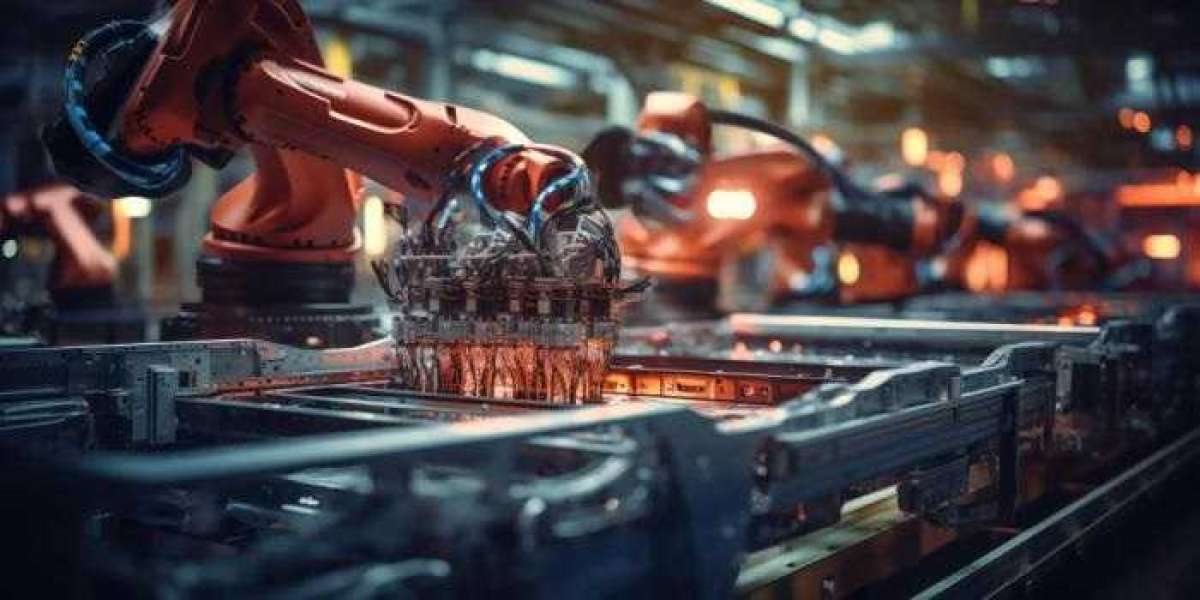Manufacturing is undergoing a profound transformation, driven by advancements in technology, shifts in global markets, and evolving customer demands. Central to this evolution is the field of manufacturing software development. As industries pivot towards more efficient, agile, and innovative practices, software solutions are becoming indispensable in optimizing operations, enhancing productivity, and fostering sustainable growth. This article delves into the future of manufacturing by exploring the emerging trends in software development that are shaping the industry.
Introduction
Manufacturing has always been at the forefront of technological innovation. From the steam engine to the assembly line, each era has brought forth new tools and techniques that have revolutionized production processes. Today, we stand on the brink of another significant transformation, driven by digitalization and software development. The integration of advanced software into manufacturing processes is not only enhancing efficiency but also enabling unprecedented levels of customization, flexibility, and sustainability.
The Evolution of Manufacturing Software Development
Manufacturing software development has evolved significantly over the past few decades. Initially, software solutions were primarily focused on automating specific tasks, such as inventory management or quality control. However, with the advent of advanced technologies like artificial intelligence (AI), machine learning (ML), and the Internet of Things (IoT), manufacturing software has become more sophisticated and integral to the entire production lifecycle.
Early Days: Automation and Control
In the early days, manufacturing software was largely about automation and control. Programmable logic controllers (PLCs) and supervisory control and data acquisition (SCADA) systems were among the first to be widely adopted, providing the backbone for automated production lines. These systems allowed manufacturers to monitor and control their processes more effectively, leading to increased productivity and reduced downtime.
The Rise of Enterprise Resource Planning (ERP)
The introduction of ERP systems marked a significant shift in manufacturing software development. ERP systems integrated various functions across the organization, from finance and human resources to supply chain and production management. This holistic approach allowed for better coordination and decision-making, helping manufacturers streamline their operations and improve efficiency.
The Digital Revolution
The digital revolution brought with it a new wave of software solutions. Advanced analytics, cloud computing, and mobile technologies began to play a crucial role in manufacturing. These innovations enabled real-time data collection and analysis, predictive maintenance, and remote monitoring, paving the way for smarter, more responsive production systems.
Emerging Trends in Manufacturing Software Development
As we look towards the future, several key trends are poised to shape the landscape of manufacturing software development. These trends are driven by the need for greater efficiency, flexibility, and sustainability in manufacturing processes.
1. Artificial Intelligence and Machine Learning
AI and ML are transforming manufacturing by enabling smarter decision-making and process optimization. AI algorithms can analyze vast amounts of data to identify patterns and insights that would be impossible for humans to discern. This capability is being leveraged in various ways, from predictive maintenance and quality control to supply chain optimization and demand forecasting.
Predictive Maintenance
One of the most promising applications of AI in manufacturing is predictive maintenance. By analyzing data from sensors and other sources, AI can predict when a machine is likely to fail and recommend maintenance before a breakdown occurs. This not only reduces downtime but also extends the lifespan of equipment and lowers maintenance costs.
Quality Control
AI is also being used to enhance quality control processes. Machine learning algorithms can detect defects in products more accurately and quickly than human inspectors. This ensures that only high-quality products make it to market, reducing waste and increasing customer satisfaction.
2. Internet of Things (IoT)
The IoT is revolutionizing manufacturing by connecting machines, devices, and systems to create a seamless flow of information. This connectivity enables real-time monitoring and control of production processes, leading to greater efficiency and responsiveness.
Smart Factories
IoT is at the heart of the smart factory concept, where machines and systems communicate with each other to optimize production. Smart factories can adapt to changes in demand and production conditions in real-time, resulting in more flexible and efficient operations.
Supply Chain Management
IoT is also transforming supply chain management. By providing real-time visibility into inventory levels, shipment status, and other critical factors, IoT-enabled supply chains can respond more quickly to disruptions and changes in demand. This leads to improved efficiency and customer satisfaction.
3. Cloud Computing
Cloud computing is playing a critical role in the evolution of manufacturing software. By providing scalable and flexible computing resources, the cloud enables manufacturers to deploy and manage software solutions more efficiently.
Collaboration and Data Sharing
Cloud-based platforms facilitate collaboration and data sharing across different locations and departments. This is particularly important for manufacturers with global operations, as it allows for better coordination and decision-making.
Cost Savings
By leveraging cloud computing, manufacturers can reduce their IT infrastructure costs and improve scalability. Cloud-based solutions can be easily scaled up or down based on demand, providing manufacturers with the flexibility to adapt to changing market conditions.
4. Digital Twins
Digital twin technology is another emerging trend that is set to revolutionize manufacturing. A digital twin is a virtual replica of a physical product, process, or system that can be used for simulation, analysis, and optimization.
Product Development
In product development, digital twins allow engineers to test and refine designs in a virtual environment before moving to physical prototyping. This reduces the time and cost associated with product development and leads to better-quality products.
Process Optimization
Digital twins can also be used to optimize production processes. By simulating different scenarios and analyzing the results, manufacturers can identify bottlenecks and inefficiencies and make data-driven decisions to improve performance.
5. Augmented Reality (AR) and Virtual Reality (VR)
AR and VR are becoming increasingly important tools in manufacturing. These technologies provide immersive experiences that can enhance training, maintenance, and design processes.
Training and Maintenance
AR and VR can be used to provide realistic training experiences for employees, helping them to learn new skills more quickly and effectively. In maintenance, AR can provide technicians with real-time information and guidance, making it easier to diagnose and repair issues.
Design and Prototyping
In design and prototyping, AR and VR allow engineers to visualize and interact with 3D models in a virtual environment. This enables more effective collaboration and iteration, leading to better designs and faster time-to-market.
6. Additive Manufacturing (3D Printing)
Additive manufacturing, or 3D printing, is another trend that is reshaping the manufacturing landscape. This technology allows for the creation of complex and customized parts with greater precision and less waste than traditional manufacturing methods.
Customization and Flexibility
3D printing enables manufacturers to produce customized products on-demand, without the need for expensive molds or tooling. This flexibility allows for greater innovation and responsiveness to customer needs.
Sustainability
Additive manufacturing is also more sustainable than traditional methods, as it generates less waste and uses fewer resources. This is becoming increasingly important as manufacturers seek to reduce their environmental impact.
7. Cybersecurity
As manufacturing becomes more digitized and connected, cybersecurity is becoming a critical concern. Protecting sensitive data and systems from cyber threats is essential to ensure the integrity and reliability of manufacturing operations.
Risk Management
Manufacturers need to implement robust cybersecurity measures to protect against threats such as data breaches, ransomware, and industrial espionage. This includes investing in secure software development practices and implementing comprehensive risk management strategies.
Compliance
Compliance with cybersecurity regulations and standards is also essential. Manufacturers must stay up-to-date with the latest requirements and ensure that their systems and processes are in compliance.
8. Advanced Robotics and Automation
Advanced robotics and automation are playing a crucial role in the future of manufacturing. These technologies are enabling manufacturers to achieve higher levels of efficiency, precision, and flexibility.
Collaborative Robots (Cobots)
Collaborative robots, or cobots, are designed to work alongside human workers, assisting with tasks that require precision and strength. Cobots are more flexible and easier to program than traditional industrial robots, making them ideal for a wide range of applications.
Autonomous Systems
Autonomous systems, such as drones and autonomous vehicles, are also becoming more prevalent in manufacturing. These systems can perform tasks such as material handling, inspection, and delivery, reducing the need for human intervention and increasing efficiency.
9. Blockchain
Blockchain technology is emerging as a powerful tool for enhancing transparency and traceability in manufacturing. By providing a secure and immutable record of transactions, blockchain can improve supply chain visibility and trust.
Supply Chain Transparency
Blockchain can be used to track the movement of goods and materials through the supply chain, providing real-time visibility and reducing the risk of fraud and counterfeiting. This is particularly important for industries such as pharmaceuticals and food, where traceability is critical.
Smart Contracts
Smart contracts, which are self-executing contracts with the terms of the agreement directly written into code, can also be used in manufacturing. These contracts can automate processes such as payment and delivery, reducing administrative overhead and improving efficiency.
The Impact of Emerging Trends on Manufacturing
The emerging trends in manufacturing software development are having a profound impact on the industry. These trends are driving significant changes in how manufacturers operate, compete, and innovate.
Increased Efficiency and Productivity
The integration of advanced software solutions is enabling manufacturers to achieve higher levels of efficiency and productivity. By automating routine tasks, optimizing processes, and providing real-time insights, these solutions are helping manufacturers to reduce costs and increase output.
Greater Flexibility and Agility
Manufacturing software development is also enhancing the flexibility and agility of production systems. Advanced technologies such as AI, IoT, and 3D printing are allowing manufacturers to respond more quickly to changes in demand and market conditions, enabling them to stay competitive in a rapidly changing environment.
Improved Quality and Innovation
The use of digital twins, AR/VR, and other advanced tools is enabling manufacturers to develop better-quality products and innovate more effectively. By providing new ways to design, test, and refine products, these technologies are helping manufacturers to bring new ideas to market faster and more efficiently.
Enhanced Sustainability
Sustainability is becoming an increasingly important consideration for manufacturers. The adoption of technologies such as additive manufacturing and IoT is helping to reduce waste and resource consumption, while also enabling more sustainable production practices. This is not only beneficial for the environment but also for the bottom line, as it can lead to cost savings and improved reputation.
Strengthened Cybersecurity
As manufacturing becomes more digitized, the need for robust cybersecurity measures is becoming increasingly critical. By investing in secure software development practices and implementing comprehensive risk management strategies, manufacturers can protect their operations from cyber threats and ensure the integrity of their systems and data.
Conclusion
The future of manufacturing is being shaped by a wave of emerging trends in software development. From AI and IoT to cloud computing and blockchain, these technologies are revolutionizing the industry by enabling greater efficiency, flexibility, and sustainability. As manufacturers continue to adopt and integrate these advanced software solutions, they will be better positioned to compete in a rapidly changing market and meet the evolving needs of their customers.
Manufacturing software development is at the heart of this transformation, driving innovation and creating new opportunities for growth and success. By staying at the forefront of these trends and investing in the latest technologies, manufacturers can not only improve their operations but also build a more resilient and sustainable future. The journey ahead is full of potential, and the advancements in manufacturing software development will undoubtedly play a pivotal role in shaping the industry for years to come.








